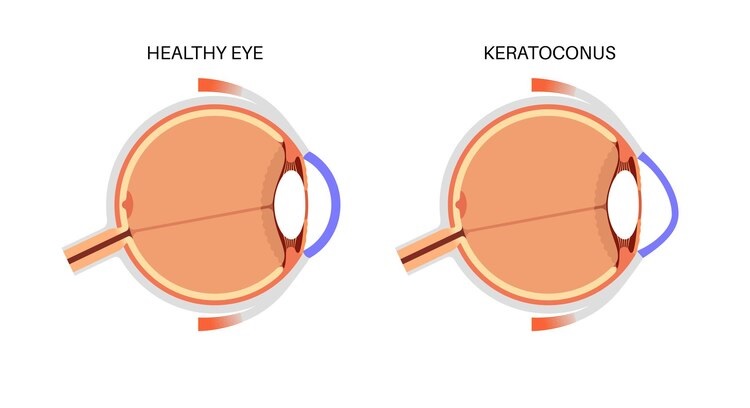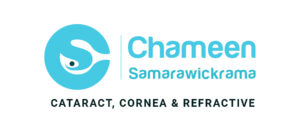
Are you getting blurred vision, ghosting, or halos when you see lights? It’s not always a question of needing a new pair of glasses. You might be one of the thousands Australians living with keratoconus, a mysteriously progressive eye condition that is just as difficult to understand as it is to pronounce.
But there is good news: we are living in a golden age of medical innovation that when it comes to keratoconus. Procedures can now stop the disease in its tracks, and new technologies like ICL (implantable collamer lens) can revolutionize vision treatment.
Let’s demystify your treatment options—starting with the guiding principle:
First, stop keratoconus from getting worse. Then, improve vision.
What is Keratoconus Exactly?

Keratoconus is an eye disease that affects the cornea—the transparent outer layer of your eye. Instead of maintaining its normal dome shape, the cornea gradually thins and bulges outward into a cone-like shape. This abnormal curvature distorts the way light enters the eye, leading to blurry or distorted vision, increased sensitivity to light, and frequent changes in your eyeglass prescription.
It usually starts in your late adolescence or early twenties and deteriorates over time. The severity of keratoconus varies from person to person, but if left untreated, the cornea can become severely damaged, leading to significant vision loss.
The Modern Keratoconus Toolkit: Step by Step
1. Eyeglasses and Contact Lenses (the Starting Line)
Initially, simple vision correction—such as glasses or soft contact lenses—can suffice, but once keratoconus progresses, they are no longer effective due to the corneal irregularity.
At this point, your eye care provider may offer you one or more of the following:
- Rigid Gas Permeable (RGP) lenses: These lenses retain their shape when placed on an irregular cornea, providing clear vision.
- Scleral lenses: These larger, more stable lenses sit on the sclera (the white part of the eye) and vault over the cornea, designed for comfort and clarity.
Great for vision. Not a cure.
So what’s next? Stabilize the cornea.
2. Corneal Cross-Linking (CXL)
CXL is the ‘gold standard’ for halting the progression of keratoconus. The procedure involves applying riboflavin (vitamin B2) eye drops to the cornea, then activating the riboflavin with UV light. The combined effect strengthens the collagen fibers in the cornea.
Key facts:
- Does not reshape the cornea or restore vision.
- Its purpose is to prevent further damage.
- Often the first step before considering vision correction procedures like ICL.
- Think of CXL as hitting the brakes—it doesn’t reverse the damage, but it stops it from worsening.
3. CAIRS (Corneal Allogenic Intrastromal Ring Segments)
A new development in keratoconus treatment, CAIRS involves using donor corneal tissue to create ring segments that are implanted into your cornea. The rings help flatten the cone-shaped bulge and enhance vision without introducing synthetic rings.
Why CAIRS is different:
- Uses biological material, reducing the risk of rejection and infection.
- Can dramatically reshape the cornea and improve vision.
- A great follow-up to CXL for moderately advanced keratoconus.
- Available at Dr. Chameen Sams’ clinic, one of the few clinics in Australia experienced with this treatment.
- This reversible, natural solution bridges the gap between managing the disease and achieving effective vision correction.
4. ICL (Implantable Collamer Lens)
Now, for the most exciting part: restoring crystal-clear vision. ICL is a small, foldable lens placed between the iris and natural lens of the eye. Unlike LASIK or PRK, ICL doesn’t alter the cornea, making it an excellent option for people with keratoconus and other conditions involving thin corneas.
Here’s why ICL patients love them:
- No changes to the cornea—safe for irregular corneas!
- Removable and reversible—keep your future options open.
- Made from biocompatible Collamer, ensuring compatibility with contact lenses.
- Superior vision quality, often better than glasses or contact lenses.
- Built-in UV protection—perfect for outdoor activities.
- ICL is primarily recommended for patients with stable keratoconus, usually after CXL and possibly CAIRS. It provides outstanding vision with minimal maintenance.
5. Corneal Transplants
When all else fails—particularly in cases where the cornea is severely scarred or dangerously thin—a corneal transplant may be the only viable option. Though rare, it remains effective and is safer than ever before.
What’s Right for You?
Your treatment plan should be as unique as your eyes. The ideal results often involve a multi-step approach:
- CXL to stabilize progression.
- CAIRS to reshape and optimize the cornea.
- ICL to provide crystal-clear vision.
Early action and diagnosis give you more treatment options and the best possible results.
Final Thoughts: Let’s Clear Things Up—Literally
While keratoconus may be a lifelong condition, it doesn’t have to darken your life. Advanced treatments such as CXL, CAIRS, and ICL mean you can regain both your vision and your confidence. We offer personalized care through the most cutting-edge keratoconus management procedures. Whether you’re just starting to notice symptoms or you’ve been living with keratoconus for years, we’re here to guide you to the clearest future possible.
